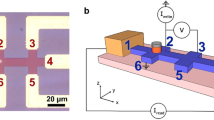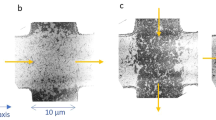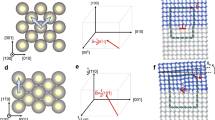Abstract
Antiferromagnets are magnetically ordered materials without a macroscopic magnetization. As a result, they could be of use in the development of memory devices because data cannot be erased by external magnetic fields. However, this also makes it difficult to electrically control their magnetic order (Néel vector). Here, we show that pillars of antiferromagnetic PtMn, which are grown on a heavy-metal layer and have diameters down to 800 nm, can be reversibly switched between different magnetic states by electric currents. The devices are based on materials that are typically used in the magnetic memory industry, and we observe switching down to a current density of ~2 MA cm−2. Furthermore, by varying the amplitude of the writing current, multilevel memory characteristics can be achieved. Micromagnetic simulations suggest that the different magnetic states may consist of domains separated by domain walls with vortex and anti-vortex textures that move in response to current, modifying the average Néel vector.
This is a preview of subscription content, access via your institution
Access options
Access Nature and 54 other Nature Portfolio journals
Get Nature+, our best-value online-access subscription
$29.99 / 30 days
cancel any time
Subscribe to this journal
Receive 12 digital issues and online access to articles
$119.00 per year
only $9.92 per issue
Buy this article
- Purchase on Springer Link
- Instant access to full article PDF
Prices may be subject to local taxes which are calculated during checkout






Similar content being viewed by others
Data availability
The data that support the plots within this paper and other findings of this study are available from the corresponding authors upon reasonable request.
References
Železný, J., Wadley, P., Olejník, K., Hoffmann, A. & Ohno, H. Spin transport and spin torque in antiferromagnetic devices. Nat. Phys. 14, 220–228 (2018).
Jungwirth, T. et al. The multiple directions of antiferromagnetic spintronics. Nat. Phys. 14, 200–203 (2018).
Jungfleisch, M. B., Zhang, W. & Hoffmann, A. Perspectives of antiferromagnetic spintronics. Phys. Lett. A 382, 865–871 (2018).
Gomonay, O., Jungwirth, T. & Sinova, J. Concepts of antiferromagnetic spintronics. Phys. Status Solidi Rapid Res. Lett. 11, 1700022 (2017).
Baltz, V. et al. Antiferromagnetic spintronics. Rev. Mod. Phys. 90, 015005 (2018).
Jungwirth, T., Marti, X., Wadley, P. & Wunderlich, J. Antiferromagnetic spintronics. Nat. Nanotechnol. 11, 231–241 (2016).
Olejnik, K. et al. Antiferromagnetic CuMnAs multi-level memory cell with microelectronic compatibility. Nat. Commun. 8, 15434 (2017).
Marti, X. et al. Room-temperature antiferromagnetic memory resistor. Nat. Mater. 13, 367–374 (2014).
Olejník, K. et al. Terahertz electrical writing speed in an antiferromagnetic memory. Sci. Adv. 4, eaar3566 (2018).
Gomonay, E. V. & Loktev, V. M. Spintronics of antiferromagnetic systems (Review Article). Low Temp. Phys. 40, 17–35 (2014).
Khymyn, R. et al. Ultra-fast artificial neuron: generation of picosecond-duration spikes in a current-driven antiferromagnetic auto-oscillator. Sci. Rep. 8, 15727 (2018).
Sapozhnik, A. A. et al. Manipulation of antiferromagnetic domain distribution in Mn2Au by ultrahigh magnetic fields and by strain. Phys. Status Solidi Rapid Res. Lett. 11, 1600438 (2017).
Shick, A. B., Khmelevskyi, S., Mryasov, O. N., Wunderlich, J. & Jungwirth, T. Spin–orbit coupling induced anisotropy effects in bimetallic antiferromagnets: a route towards antiferromagnetic spintronics. Phys. Rev. B 81, 212409 (2010).
Ohldag, H. et al. Spin reorientation at the antiferromagnetic NiO(001) surface in response to an adjacent ferromagnet. Phys. Rev. Lett. 86, 2878–2881 (2001).
Wang, Y. Y., Song, C., Zhang, J. Y. & Pan, F. Role of an ultrathin platinum seed layer in antiferromagnet-based perpendicular exchange coupling and its electrical manipulation. J. Magn. Magn. Mater. 428, 431–436 (2017).
Wang, Y. et al. Electrical control of the exchange spring in antiferromagnetic metals. Adv. Mater. 27, 3196–3201 (2015).
Zheng, G. et al. Electric field control of magnetization direction across the antiferromagnetic to ferromagnetic transition. Sci. Rep. 7, 5366 (2017).
Barra, A., Domann, J., Kim, K. W. & Carman, G. Voltage control of antiferromagnetic phases at near-terahertz frequencies. Phys. Rev. Appl. 9, 034017 (2018).
Lopez-Dominguez, V., Almasi, H. & Amiri, P. K. Picosecond electric field induced switching of antiferromagnets. Phys. Rev. Appl. 11, 024019 (2019).
Manz, S. et al. Reversible optical switching of antiferromagnetism in TbMnO3. Nat. Photon. 10, 653–656 (2016).
Fiebig, M. et al. Ultrafast magnetization dynamics of antiferromagnetic compounds. J. Phys. D 41, 164005 (2008).
Kampfrath, T. et al. Coherent terahertz control of antiferromagnetic spin waves. Nat. Photon. 5, 31–34 (2010).
Wadley, P. et al. Electrical switching of an antiferromagnet. Science 351, 587–590 (2016).
Grzybowski, M. J. et al. Imaging current-induced switching of antiferromagnetic domains in CuMnAs. Phys. Rev. Lett. 118, 057701 (2017).
Godinho, J. et al. Electrically induced and detected Neel vector reversal in a collinear antiferromagnet. Nat. Commun. 9, 4686 (2018).
Bodnar, S. Y. et al. Writing and reading antiferromagnetic Mn2Au by Neel spin–orbit torques and large anisotropic magnetoresistance. Nat. Commun. 9, 348 (2018).
Zhou, X. F. et al. From fieldlike torque to antidamping torque in antiferromagnetic Mn2Au. Phys. Rev. Appl. 11, 054030 (2019).
Sapozhnik, A. A. et al. Direct imaging of antiferromagnetic domains in Mn2Au manipulated by high magnetic fields. Phys. Rev. B 97, 134429 (2018).
Barthem, V. M. T. S., Colin, C. V., Haettel, R., Dufeu, D. & Givord, D. Easy moment direction and antiferromagnetic domain wall motion in Mn2Au. J. Magn. Magn. Mater. 406, 289–292 (2016).
Meinert, M., Graulich, D. & Matalla-Wagner, T. Electrical switching of antiferromagnetic Mn2Au and the role of thermal activation. Phys. Rev. Appl. 9, 064040 (2018).
Dunz, M., Matalla-Wagner, T. & Meinert, M. Spin–orbit torque induced electrical switching of antiferromagnetic MnN. Preprint at https://arxiv.org/pdf/1907.02386.pdf (2019).
Baldrati, L. et al. Full angular dependence of the spin Hall and ordinary magnetoresistance in epitaxial antiferromagnetic NiO(001)/Pt thin films. Phys. Rev. B 98, 024422 (2018).
Moriyama, T., Oda, K., Ohkochi, T., Kimata, M. & Ono, T. Spin torque control of antiferromagnetic moments in NiO. Sci. Rep. 8, 14167 (2018).
Fischer, J. et al. Spin Hall magnetoresistance in antiferromagnet/heavy-metal heterostructures. Phys. Rev. B 97, 014417 (2018).
Khymyn, R., Lisenkov, I., Tiberkevich, V., Ivanov, B. A. & Slavin, A. Antiferromagnetic THz-frequency Josephson-like oscillator driven by spin current. Sci. Rep. 7, 43705 (2017).
Manipatruni, S., Nikonov, D. E. & Young, I. A. Beyond CMOS computing with spin and polarization. Nat. Phys. 14, 338–343 (2018).
Tehrani, S. et al. Recent developments in magnetic tunnel junction MRAM. IEEE Trans. Magn. 36, 2752–2757 (2000).
Hals, K. M., Tserkovnyak, Y. & Brataas, A. Phenomenology of current-induced dynamics in antiferromagnets. Phys. Rev. Lett. 106, 107206 (2011).
Liu, Z. et al. Epitaxial growth of intermetallic MnPt films on oxides and large exchange bias. Adv. Mater. 28, 118–123 (2016).
Gouva, M. E., Wysin, G. M., Bishop, A. R. & Mertens, F. G. Vortices in the classical two-dimensional anisotropic Heisenberg model. Phys. Rev. B 39, 11840–11849 (1989).
Chmiel, F. P. et al. Observation of magnetic vortex pairs at room temperature in a planar ɑ-Fe2O3/Co heterostructure. Nat. Mater. 17, 581–585 (2018).
Wu, J. et al. Direct observation of imprinted antiferromagnetic vortex states in CoO/Fe/Ag(001) discs. Nat. Phys. 7, 303–306 (2011).
Zhang, W. et al. Spin Hall effects in metallic antiferromagnets. Phys. Rev. Lett. 113, 196602 (2014).
Haney, P. M., Lee, H.-W., Lee, K.-J., Manchon, A. & Stiles, M. D. Current induced torques and interfacial spin–orbit coupling: semiclassical modeling. Phys. Rev. B 87, 174411 (2013).
Yamane, Y., Ieda, J.i. & Sinova, J. Spin–transfer torques in antiferromagnetic textures: efficiency and quantification method. Phys. Rev. B 94, 054409 (2016).
Wadley, P. et al. Current polarity-dependent manipulation of antiferromagnetic domains. Nat. Nanotechnol. 13, 362–365 (2018).
Di Ventra, M., Pershin, Y. V. & Chua, L. O. Circuit elements with memory: memristors, memcapacitors, and meminductors. Proc. IEEE 97, 1717–1724 (2009).
Mayergoyz, I. D. Mathematical models of hysteresis. Phys. Rev. Lett. 56, 1518–1521 (1986).
Zhang, S. et al. Spin–orbit-torque-driven multilevel switching in Ta/CoFeB/MgO structures without initialization. Appl. Phys. Lett. 114, 042401 (2019).
Zhang, S. et al. A spin–orbit-torque memristive device. Adv. Electron. Mater. 5, 1800782 (2019).
Yan, H. et al. A piezoelectric, strain-controlled antiferromagnetic memory insensitive to magnetic fields. Nat. Nanotechnol. 14, 131–136 (2019).
Park, B. G. et al. A spin-valve-like magnetoresistance of an antiferromagnet-based tunnel junction. Nat. Mater. 10, 347–351 (2011).
Manchon, A. et al. Current-induced spin-orbit torques in ferromagnetic and antiferromagnetic systems. Rev. Mod. Phys. 91, 035004 (2019).
Gomonay, H. V. & Loktev, V. M. Spin transfer and current-induced switching in antiferromagnets. Phys. Rev. B 81, 144427 (2010).
Puliafito, V. et al. Micromagnetic modeling of terahertz oscillations in an antiferromagnetic material driven by the spin Hall effect. Phys. Rev. B 99, 024405 (2019).
Acknowledgements
This work was supported by a grant from the National Science Foundation, Division of Electrical, Communications and Cyber Systems (NSF ECCS-1853879), and in part by the Air Force Office of Scientific Research (AFOSR FA9550-15-1-0377). This work also utilized the Northwestern University Micro/Nano Fabrication Facility (NUFAB), which is partially supported by the Soft and Hybrid Nanotechnology Experimental (SHyNE) Resource (NSF ECCS-1542205), the Materials Research Science and Engineering Center (DMR-1720139), the State of Illinois and Northwestern University. For part of the sample fabrication, use of the Center for Nanoscale Materials, an Office of Science user facility, was supported by the US Department of Energy, Office of Science, Office of Basic Energy Sciences, under contract no. DE-AC02-06CH11357. G.F. and F.G. also acknowledge support from PETASPIN.
Author information
Authors and Affiliations
Contributions
J.S., V.L.-D., H.A., G.F. and P.K.A. designed the devices. V.L.-D., J.S. and H.A. deposited the materials. J.S. fabricated the devices. V.L.-D., J.S. and C.W. performed the measurements. F.G. and G.F. performed the micromagnetic simulations. P.K.A., G.F., V.L.-D. and J.S. wrote the manuscript with contributions from the other authors. All authors discussed the results, contributed to the data analysis and commented on the manuscript. J.S. and V.L.-D. contributed equally to this research. The study was performed under the supervision of P.K.A.
Corresponding authors
Ethics declarations
Competing interests
The authors declare no competing interests.
Additional information
Publisher’s note Springer Nature remains neutral with regard to jurisdictional claims in published maps and institutional affiliations.
Supplementary Information
Supplementary Information
Supplementary Notes 1–8 and Figs. 1–9.
Supplementary Video 1
The time-domain evolution of the spatial distribution of the Néel vector for the simulation described in Fig. 3b.
Rights and permissions
About this article
Cite this article
Shi, J., Lopez-Dominguez, V., Garesci, F. et al. Electrical manipulation of the magnetic order in antiferromagnetic PtMn pillars. Nat Electron 3, 92–98 (2020). https://doi.org/10.1038/s41928-020-0367-2
Received:
Accepted:
Published:
Issue Date:
DOI: https://doi.org/10.1038/s41928-020-0367-2
This article is cited by
-
Room temperature chirality switching and detection in a helimagnetic MnAu2 thin film
Nature Communications (2024)
-
Effective electrical manipulation of a topological antiferromagnet by orbital torques
Nature Communications (2024)
-
Electrical manipulation and detection of antiferromagnetism in magnetic tunnel junctions
Nature Electronics (2023)
-
Current-controlled antiferromagnetic memory
Nature Electronics (2023)
-
Perpendicular full switching of chiral antiferromagnetic order by current
Nature (2022)



